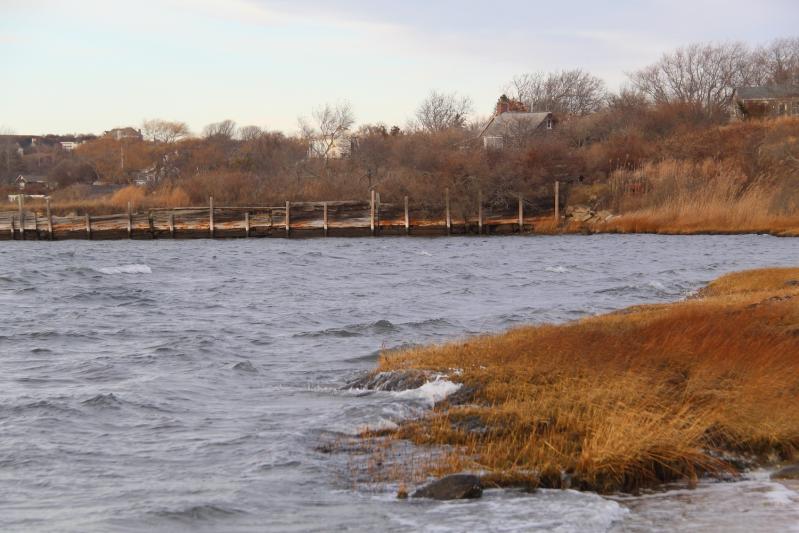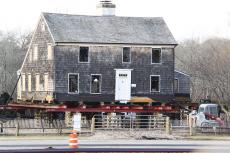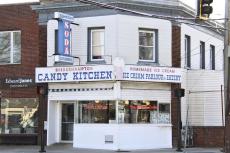"As it fails, it will continue to leak material into Lake Montauk," said Brian Frank, chief environmental analyst for East Hampton Town, of an aging bulkhead on the east side of Lake Montauk, where David Zwirner, a New York City gallerist, hopes to create an artists' retreat.
Speaking last week before a meeting of the town planning board, he said Mr. Zwirner plans to completely rebuild 17 existing cottages and a large single-family residence at 31 East Lake Drive, which is bordered by freshwater wetlands. It's a large project in a sensitive area, and construction is estimated to take two years, a timeline Mr. Frank described as "ambitious, based on observations of smaller projects on East Lake Drive." The final product would be called Bridgeford Cottages.
Many of the issues that the Planning Department wanted addressed have been addressed, Mr. Frank said, but not the bulkhead.
The goal is to reconstruct the bulkhead, not remove it, said Tiffany Scarlato, a land use lawyer representing the applicant. "We were told we couldn't reconstruct" the coastal structures, she told board members. "Rather than not have them at all, the client chooses to maintain them in their current condition."
The Zwirners do not necessarily have to take the planning board's determination, whatever it may be, as final, Mr. Frank observed. "They're free to get a determination from the Building Department to support" reconstruction, he said. However, because the property is in a Harbor Protection Overlay District, they would need to obtain a variance to rebuild, and he doubted that one would be granted. "They would not be a strong candidate for granting a variance there," he said. "Everybody recognizes that this is an environmentally sensitive area."
"They're not protecting anything with the bulkhead," Mr. Frank added, describing it as "more of a makeshift pier."
"Not doing anything about the structures along the shoreline is a big deal to me," said Louis Cortese, a board member. "I would not recommend approval unless that item is taken care of."
But the board does not have the legal authority to compel the Zwirners to do anything with the bulkhead. They are free to let it rot, if they so choose. "The applicant is not obligated to do anything with it. It's not an illegal structure," Mr. Frank explained.
However, he added, "It doesn't make sense that you're going to have a bunch of brand-new, modern, energy-efficient structures on the property with a dilapidated, failing coastal structure. I really want the applicant to reconsider the possibility of removing it, which would be a significant improvement to the shoreline conditions on the property."
Britton Bistrian, the Zwirners' land-use consultant, did not immediately return a call for comment.
Apart from the deteriorating bulkhead, the Planning Department wants the applicants to clarify the construction protocol, meaning its order and timing, as the property is in a residential neighborhood. Samuel Kramer, board chairman, said he wanted the protocol to be very specific, "so the people who live nearby know what they're going to be dealing with and how long they're going to be dealing with it."
Ian Calder-Piedmonte, a board member, said it was most important to "make sure the environment is protected" during construction, and, given the residential nature of the neighborhood, to make sure parking is contained to the location.
In December, when the application was last before the Planning Board, one big issue was defining the relationship between the large residence and the cottages. Worries have been dispelled on that score by a proposed covenant specifying that the house and nearby yoga pavilion will not be used for commercial purposes, or in conjunction with the cottages.
Landscaping and lighting have since been improved. A geothermal field that was initially proposed has been removed; planners said it was too close to the shoreline. A concrete driveway would now be crushed gravel or shells. The amount of sanitary flow required for the cottages was addressed by default by the Suffolk County Health Department, because each cottage contains a kitchenette, which immediately upgrades the amount of sanitary flow required.
The big issue was the bulkhead, and the board could not understand why the applicants would want to watch it slowly fall apart.
"Lake Montauk could use all the love it can get," said Mr. Frank. "Removing something that is an environmental and safety hazard is only a benefit to everybody."




